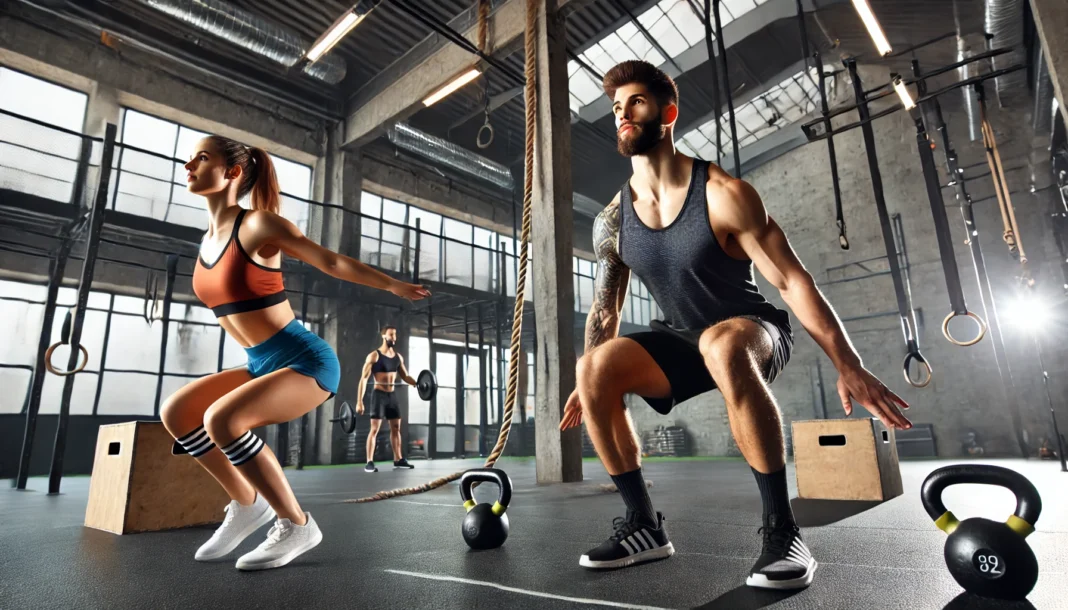The Power of HIIT Functional Training: Strength, Endurance, and Mobility in One Program
Functional fitness has transformed the way people approach exercise, shifting the emphasis from isolated muscle training to movements that enhance real-world strength and mobility. One of the most efficient methods of achieving peak physical performance is through HIIT functional training, a highly dynamic exercise system that integrates the principles of functional fitness with the intensity of high-intensity interval training (HIIT). This approach not only builds muscle and burns fat but also optimizes mobility, endurance, and agility in ways that traditional workout regimens often fail to address.
Unlike conventional resistance training that isolates individual muscle groups, functional high-intensity training focuses on movement patterns that replicate everyday activities. Squatting, jumping, pushing, pulling, and rotational movements engage multiple muscle groups simultaneously, enhancing coordination and reducing the risk of injury. The inclusion of high-intensity intervals elevates heart rate rapidly, maximizing calorie burn and improving cardiovascular health while reinforcing strength and flexibility.
What makes HIIT functional training stand out is its efficiency. In a world where time constraints often prevent individuals from engaging in lengthy gym sessions, this training methodology provides a solution that delivers results in shorter, more effective workouts. Sessions typically last between 20 to 45 minutes, yet they yield substantial improvements in muscle endurance, metabolic rate, and functional capacity. This makes it an ideal training system for busy professionals, athletes, and fitness enthusiasts looking for maximum results in minimal time.
By integrating functional high-intensity training into a fitness routine, individuals benefit from improved movement mechanics, enhanced core stability, and increased resistance to injuries. The rapid bursts of effort, followed by short recovery periods, challenge both aerobic and anaerobic systems, ensuring that the body adapts to diverse physical demands. Unlike monotonous cardio workouts, HIIT-based functional training keeps the body engaged through constantly varied exercises, making each session stimulating and progressive.
Understanding the science behind HIIT functional training reveals why it has gained widespread popularity. This approach to fitness not only enhances muscular and cardiovascular performance but also improves neuromuscular coordination. The combination of explosive movements and controlled stability exercises ensures that the body develops the agility required for sports, occupational activities, and everyday tasks. By emphasizing full-body movement efficiency, HIIT-based functional fitness promotes longevity, resilience, and an overall heightened level of physical capability.
You May Also Like: Functional Fitness Definition: How It Enhances Strength, Mobility, and Daily Life

The Science Behind HIIT Functional Training: A Synergistic Approach to Fitness
At the core of HIIT functional training lies a sophisticated interaction between metabolic conditioning, neuromuscular adaptation, and biomechanical efficiency. Traditional exercise programs often separate cardio and strength training into distinct categories, but functional high-intensity training merges these elements to create a seamless, highly effective workout.
One of the most significant physiological benefits of functional high-intensity training is its impact on excess post-exercise oxygen consumption (EPOC). Unlike steady-state cardiovascular exercise, which results in a gradual decline in metabolic rate post-workout, HIIT workouts create an oxygen debt that forces the body to continue burning calories at an elevated rate for hours after the session. This metabolic afterburn enhances fat loss while simultaneously promoting muscle repair and growth, making it an ideal strategy for body composition improvements.
Beyond its metabolic effects, HIIT functional training strengthens neuromuscular pathways by demanding coordination across multiple planes of motion. Traditional strength training often involves linear movements—such as leg presses or bench presses—that do not mimic real-world activity. In contrast, HIIT-based functional fitness incorporates multiplanar exercises that require stability, flexibility, and dynamic balance. Movements such as medicine ball throws, kettlebell swings, and agility drills challenge the body to recruit stabilizing muscles while executing power-based actions, reinforcing movement efficiency.
Another key component of functional high-intensity training is its ability to improve cardiovascular conditioning without excessive joint strain. Running on a treadmill for extended periods may lead to repetitive impact injuries, but HIIT-based training distributes workload across multiple muscle groups, reducing localized stress on any single joint. Incorporating low-impact, high-intensity exercises such as sled pushes, battle ropes, and bodyweight plyometrics allows individuals to achieve cardiovascular benefits without the wear and tear associated with long-distance running.
From an adaptability standpoint, HIIT functional training is highly scalable. Whether working with a beginner or an elite athlete, the intensity, complexity, and resistance levels can be adjusted to suit individual capabilities. A well-designed HIIT-based functional training session accommodates progressions and regressions, ensuring that every participant is challenged appropriately while minimizing the risk of overtraining or injury.

Building Strength and Power with HIIT Functional Training
Strength development is one of the defining characteristics of HIIT functional training, distinguishing it from conventional cardiovascular workouts. Unlike traditional weightlifting, which often isolates muscles in controlled movements, functional high-intensity training emphasizes compound, multi-joint exercises that build real-world strength.
Explosive power is a crucial element of HIIT-based functional training. By integrating plyometric drills, resistance sprints, and Olympic-style lifts, the body learns to generate force quickly and efficiently. Exercises such as box jumps, kettlebell snatches, and sled drags develop fast-twitch muscle fibers, improving an individual’s ability to produce power on demand. This form of training enhances athletic performance and translates directly into improved performance in activities such as sprinting, jumping, and rapid directional changes.
Another unique aspect of functional high-intensity training is its application of time-under-tension principles. While traditional strength training often focuses on lifting heavier weights for fewer repetitions, HIIT-based functional training incorporates tempo variations that challenge muscle endurance. Controlled eccentric (lengthening) movements, followed by explosive concentric (shortening) contractions, optimize strength gains while reinforcing neuromuscular control.
Core stability plays a fundamental role in functional fitness, and HIIT functional training strengthens the core dynamically rather than through static exercises. Movements that require rotational strength, unilateral stability, and anti-rotational control—such as landmine presses, single-arm kettlebell carries, and cable woodchoppers—enhance core engagement in ways that sit-ups and crunches cannot. A strong, stable core improves postural alignment, spinal health, and overall movement mechanics, reducing the likelihood of lower back injuries.
Enhancing Mobility and Injury Prevention Through HIIT-Based Functional Training
One of the most overlooked aspects of fitness is mobility, yet it is a critical factor in overall movement efficiency and injury prevention. HIIT functional training not only enhances strength and endurance but also promotes joint mobility, reducing stiffness and improving overall range of motion.
Unlike traditional static stretching routines that isolate specific muscle groups, functional high-intensity training incorporates dynamic stretching, mobility drills, and active recovery movements. Exercises such as deep squats, lateral lunges, and dynamic thoracic rotations ensure that the body maintains fluidity and adaptability across multiple movement planes.
A key principle in HIIT-based functional training is the reinforcement of movement patterns that prevent overuse injuries. Many individuals experience joint pain and muscular imbalances due to repetitive movements performed in daily life. Sitting for prolonged periods, for instance, tightens the hip flexors and weakens the posterior chain, leading to poor movement mechanics. Functional HIIT workouts counteract these effects by strengthening neglected muscle groups, restoring proper posture, and improving overall joint alignment.
Another way HIIT functional training reduces injury risk is by focusing on proprioception—the body’s ability to sense and control movement. Balance and coordination drills challenge the nervous system to refine movement accuracy, ensuring that the body reacts efficiently to environmental changes. Whether an individual is navigating uneven terrain or absorbing impact from rapid movements, functional HIIT programming enhances overall movement intelligence.

Frequently Asked Questions (FAQ) on HIIT Functional Training
1. How does HIIT functional training influence mental resilience and cognitive performance?
HIIT functional training challenges not only physical endurance but also mental resilience by requiring focus, quick decision-making, and adaptability. The high-intensity nature of these workouts pushes individuals to overcome discomfort and fatigue, strengthening mental toughness over time. Additionally, the complex, multi-directional movements involved in functional high-intensity training stimulate neural pathways responsible for coordination and reaction time, enhancing cognitive function. Studies have shown that interval-based exercise improves memory retention, problem-solving abilities, and mood stability due to increased neuroplasticity. Regular participation in HIIT functional training can therefore contribute to better stress management, improved mental clarity, and greater confidence in both athletic and daily performance.
2. Can functional high-intensity training be beneficial for financial well-being?
While HIIT functional training is primarily focused on physical performance, it can have financial benefits by reducing medical costs associated with injuries, chronic conditions, and sedentary lifestyles. By improving joint stability, cardiovascular health, and movement efficiency, this training method decreases the likelihood of costly doctor visits, physical therapy sessions, and long-term prescription medication use. Additionally, since functional high-intensity training delivers comprehensive fitness benefits in shorter workouts, individuals can save money on excessive gym memberships or multiple fitness classes. Companies are also beginning to invest in functional fitness programs as part of workplace wellness initiatives, recognizing that healthier employees lead to fewer sick days and higher productivity. Over time, committing to HIIT functional training can lead to long-term financial savings and a higher quality of life.
3. How does HIIT functional training differ from traditional circuit training?
While both HIIT functional training and circuit training involve performing multiple exercises in sequence, there are key differences in their structure and intensity. Traditional circuit training often focuses on moderate-intensity movements performed in a continuous loop, whereas functional high-intensity training incorporates shorter, explosive bursts of effort followed by strategic recovery periods. HIIT workouts push the body into anaerobic zones, leading to greater post-workout calorie burn (EPOC effect) and metabolic adaptations. Additionally, functional high-intensity training integrates more dynamic, real-world movement patterns, enhancing overall mobility and strength rather than just endurance. This approach makes it a more effective training method for individuals looking to build power, improve agility, and increase cardiovascular capacity simultaneously.
4. What industries are investing in functional high-intensity training, and why?
Industries such as professional sports, military training, corporate wellness, and rehabilitation centers are increasingly incorporating HIIT functional training into their fitness programs. In sports, functional HIIT enhances athletic performance by improving power, endurance, and agility while reducing injury risks. The military and first responders rely on this training to develop the strength and mobility required for physically demanding tasks. In the corporate world, companies are adopting functional high-intensity training as part of employee wellness programs to boost productivity and reduce healthcare costs. Rehabilitation centers are also integrating modified HIIT workouts to aid recovery while improving joint mobility and muscular stability. The growing demand for efficient, results-driven fitness programs continues to drive investment in this innovative training method.
5. How can HIIT functional training be adapted for beginners?
Although HIIT functional training is known for its intensity, it can be modified to suit beginners by adjusting the duration, resistance, and complexity of movements. New participants can start with bodyweight exercises such as squats, lunges, and push-ups, gradually incorporating weights or resistance bands as they build strength. The work-to-rest ratio can also be adapted—beginners might perform 20 seconds of effort followed by 40 seconds of rest, rather than the typical 30:15 or 40:20 structure used in advanced HIIT. Trainers can introduce simpler versions of complex movements, such as stepping instead of jumping or performing controlled push-ups on an incline. Over time, as endurance and coordination improve, individuals can progress to more dynamic functional high-intensity training workouts with increased intensity and resistance.
6. How does HIIT functional training impact long-term mobility and joint health?
Unlike traditional high-impact cardio workouts, HIIT functional training improves joint health by incorporating exercises that enhance flexibility, stability, and muscular support around key joints. Movements such as deep squats, lateral lunges, and rotational drills promote a full range of motion while strengthening the surrounding muscles. Unlike repetitive activities such as long-distance running, which may contribute to overuse injuries, functional high-intensity training distributes stress across different muscle groups, reducing localized strain. Additionally, HIIT sessions can integrate low-impact movements like sled pushes or resistance band exercises to accommodate individuals recovering from injuries or with mobility limitations. When performed with proper technique, HIIT functional training enhances joint resilience and prolongs movement longevity.
7. What role does nutrition play in maximizing the benefits of functional high-intensity training?
Proper nutrition is essential for optimizing performance and recovery in HIIT functional training, as the intense bursts of activity require adequate fuel and post-workout replenishment. Pre-workout meals should focus on a balance of complex carbohydrates and protein to provide sustained energy and muscle support. During recovery, consuming high-quality proteins and anti-inflammatory foods can enhance muscle repair and reduce soreness. Hydration is also critical, as functional high-intensity training leads to significant sweat loss and electrolyte depletion. Without proper nutritional support, individuals may experience fatigue, hindered recovery, and diminished training effectiveness over time.
8. Can HIIT functional training be an effective alternative to traditional endurance training?
Yes, HIIT functional training can be a more time-efficient and joint-friendly alternative to traditional endurance training while delivering comparable cardiovascular benefits. Unlike long-distance running or cycling, which focus on steady-state aerobic conditioning, functional HIIT challenges both aerobic and anaerobic systems, leading to improved stamina in less time. Research indicates that short bursts of high-intensity effort can enhance VO2 max (a key indicator of cardiovascular fitness) as effectively as longer endurance sessions. Additionally, functional high-intensity training avoids repetitive stress injuries often associated with prolonged endurance training by incorporating movement variety. For individuals seeking endurance improvements without dedicating excessive time to long workouts, HIIT provides an efficient, well-rounded solution.
9. How can HIIT functional training improve athletic performance in sports?
Athletes across various disciplines benefit from HIIT functional training due to its ability to enhance explosive power, agility, and stamina. Unlike traditional weight training, which primarily develops static strength, HIIT-based functional exercises train athletes to generate force dynamically, improving speed and acceleration. Plyometric movements such as box jumps, medicine ball throws, and sprint intervals replicate real-game scenarios, preparing the body for quick reactions and sudden direction changes. Additionally, functional high-intensity training strengthens core stability, a critical factor in preventing injuries and maintaining balance under pressure. Whether in team sports, combat disciplines, or endurance events, functional HIIT provides a comprehensive approach to athletic conditioning.
10. What economic trends are driving the popularity of HIIT functional training?
Several economic factors are contributing to the rise of HIIT functional training, including the demand for time-efficient workouts, the growth of boutique fitness studios, and the integration of digital fitness platforms. Many people seek high-intensity, results-driven workouts that fit into busy schedules, making functional HIIT an attractive option. The expansion of boutique gyms specializing in functional training has also fueled interest, as consumers prioritize unique, specialized training experiences over traditional gym memberships. Additionally, the rise of fitness apps and virtual coaching has made functional high-intensity training more accessible, allowing users to follow structured HIIT programs from home. As the fitness industry continues evolving, functional HIIT is likely to remain a dominant trend due to its effectiveness and adaptability.
Conclusion: Elevating Fitness with HIIT Functional Training
The rise of HIIT functional training signifies a shift toward smarter, more effective fitness methodologies. This training style goes beyond traditional strength and cardio programs by integrating metabolic conditioning, neuromuscular coordination, and functional mobility into a single, cohesive system. By prioritizing real-world movement patterns, functional high-intensity training ensures that individuals build not only muscular strength but also endurance, agility, and resilience.
As the demand for efficient workouts continues to grow, HIIT functional training provides a sustainable, results-driven approach to fitness. Whether the goal is improving athletic performance, enhancing everyday mobility, or reducing injury risk, this training method delivers benefits that extend beyond the gym. By adopting functional HIIT workouts, individuals can cultivate a body that moves powerfully, efficiently, and injury-free, fostering long-term physical vitality and peak performance.
HIIT functional training, functional high-intensity training, strength and mobility, functional fitness, metabolic conditioning, neuromuscular training, mobility exercises, injury prevention, core stability, functional movement, agility training, endurance training, dynamic strength, postural alignment, full-body conditioning
Further Reading:
High-Intensity Functional Training (HIFT): Definition and Research Implications for Improved Fitness

